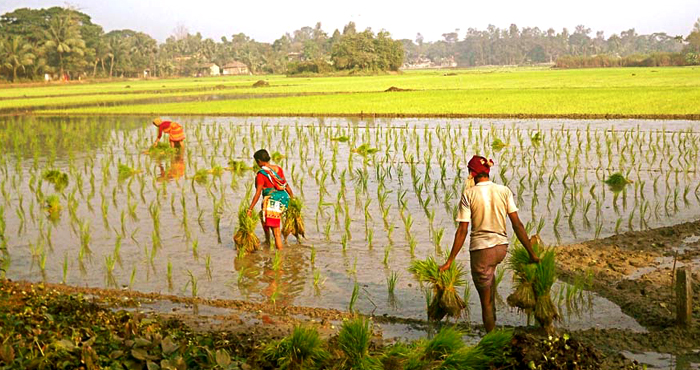Eco Park in New Town, one of the most popular weekend destinations in Bengal, now boasts of yet another attraction – Banglar Gram (Bengal Village). Chief Minister Mamata Banerjee recently visited the place and christened the project.
Eco Park has become one of the most popular tourist destinations in Kolkata and one of the finest urban parks in the country. Covering 482 acres, Mamata Banerjee has termed it a Prakriti Tirtha, or ‘nature’s pilgrimage’.
The latest addition, Banglar Gram, is a re-creation of a model village of Bengal. It has come up on three acres and is situated between the herbal garden and the musical fountain. It will be opened to the public before the Bengali New Year in mid-April.
The place will be an oasis far from the hustle and bustle of urban life. The peacefulness and serenity of the area are bound to attract the visitors.
A palki or palanquin, an ancient mode of transport in villages, and a rath or chariot, once kept in many villages and pulled during the festival of Rath Yatra, will adorn the village.
Almost every hut in the village will have a ‘tulsi mandap’, as is still found in many rural households, where a tulsi plant is worshipped every day. A chandi mandap will be set up in every locality, where the idols of various gods and goddesses will be kept and worshipped during different pujas and fairs, like the Charak festival.
Mud houses with replicas of farmers holding ploughs made of fibreglass have been set up. The houses have seasonal vegetables planted in the surrounding open spaces. Gardeners have been engaged for their cultivation. Steps have been taken to ensure that the houses are actual replicas of those in rural Bengal.
Banglar Gram will give an idea of actual village life. This will be a big attraction for tourists not only from Bengal but from other parts of the country and from other countries too.
ইকো পার্কে তৈরী হল মুখ্যমন্ত্রীর ‘বাংলার গ্রাম’
ইকো পার্কে তৈরী হওয়া গ্রাম্য পরিবেশের নতুন নামকরণ করলেন মুখ্যমন্ত্রী। নাম দিলেন, ‘বাংলার গ্রাম’। ইংরাজিতেও নাম দেওয়া হয়েছে ‘বেঙ্গল ভিলেজ’। ২০১৬ সাল থেকে এই পরিবেশ তৈরী করার উদ্যোগ নেওয়া হয়।
শিল্পীরা এখানে গড়ে তুলেছেন তুলসিতোলা থেকে লাঙল, বাজার, গ্রাম্য বাড়ি, কৃষকের মূর্তি, কুমোরের মূর্তি। এই গ্রামে ঢুকতে গেলে কুলোর তৈরী গেট পাড় হতে হবে। চারধারে আছে তালপাতার পাখা। এক একটি বিশাল পাখা দিয়ে সেই গেটের সৌন্দর্য ফুটিয়ে তোলা হয়েছে।
ইকো পার্কের উত্তর-পশ্চিম কোণে ইকো পার্ক অফিস সংলগ্ন জায়গায় প্রায় ৫ একর জায়গায় তৈরী করা হয়েছে এই গ্রাম। এখানে আগের মতোই ধান চাষ করা হচ্ছে, তাই, গ্রামের দৃশ্য ফোটাতে অসুবিধে হয়নি। ফাইবার গ্লাস দিয়ে তৈরী হয়েছে মানুষের মূর্তি। শহরের যান্ত্রিক জীবনের তাড়াহুড়োর মধ্যে এই গ্রাম যেন মানুষকে তাপমুক্ত হতে সহায়তা করবে।
সারা বিশ্বের কাছে পরিচিত এই ইকো পার্কে সারা বছরই বহু বিদেশী মানুষ এসে থাকেন। তবে আগামী দিনে এই জায়গায় প্রবেশ করতে কিঞ্চিৎ অর্থ খরচ করতে হতে পারে।
Source: Millennium Post



